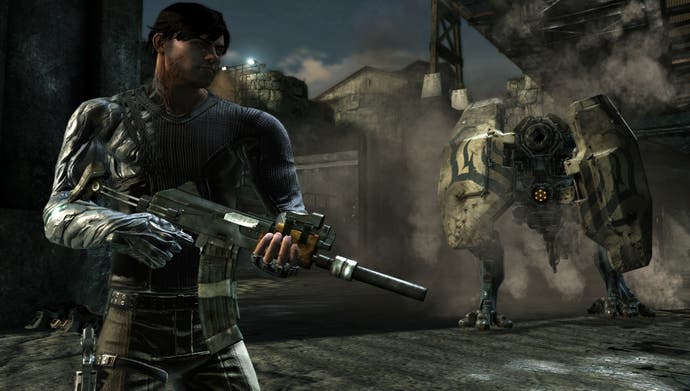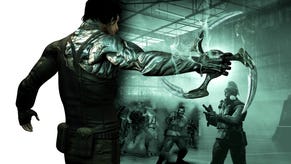Dark Sector
Armed and dangerous.
Now here's something you don't see every day: a videogame in black and white.
It's only the training level, to be fair. And to be fairer still, everything else happening on screen is something you do see every day, if you play modern videogames for fun or profit. A man points a gun over some boxes at some other men. Bullets are exchanged. Absurd gobbets of blood fly. The men who are further away fall down. Press A to open door, advises a subtitle. A is pressed, and the door opens. It reveals a corridor, with more boxes, more men, more bullets, more blood, and another door.
But shallow as it is, the fact that it's all happening in black and white does add a certain moody noirishness to this trot through the third-person-action motions. The disquiet you feel at talk of a deadly and disfiguring virus is moved up a notch. The extreme high-contrast gloss of the graphics works quite well with the bleached monochrome palette. The standardised disrepair of this biological weapons facility in good old near-future-dystopian-eastern-Europe has a mournful air to it. Our hero - CIA cleaner Hayden Tenno - looks threatening and ambiguous in his gimpish balaclava and goggles. When he abruptly dispatches the infected contact he's been sent here to find, we feel a chill, even if it was a mercy killing.

So it comes as a mild disappointment when this demo of Dark Sector, comprising the first half an hour or so of the game, shows its true colours (in every sense). After Tenno has shot down a meekly stationary gunship and been attacked by a mutant with a hard, bony exoskeleton - a key enemy type later in the game - he jumps into the sea, and wakes up without his balaclava, in colour, and being lectured by a villain with an improbable American Civil War General thing going on. Turns out that under the scary spook get-up was a sulky young man with hurt eyes and an emo mop, and now that he's got a mutated arm and his CIA buddies won't come to get him, he's got plenty to cry about. He's as chilling as a microwave set to defrost.
However, in practical terms, this is where Dark Sector gets a little more original, even if it feels like it's less. Tenno's arm, infected with the same Technocyte Virus that created his mutant enemy, allows him to grow and throw a bladed weapon called a glaive - a three-pronged boomerang of death that's reminiscent of the throwing star from the creaky 80s fantasy movie Krull, if you're old and nerdy. At close range this is lethal, sometimes allowing cutaway finishing moves, but at long range it incapacitates, and is best followed by a headshot from your pistol. Enemy weapons - standard SMGs, RPGs, shotguns and the like at this early stage - can be picked up but only for a very limited time, since their fingerprint security rejects Tenno's tainted touch.

The glaive, and the effectively one-shot weapon pick-ups, might just manage to give Dark Sector's combat a marginally different flavour, something it badly needs in this overcrowded corner of gaming. We're interested to see how the game develops in later stages; we're told that the glaive can be given elemental properties by aiming it at stuff in the environment (a light switch for electricity, an open flame for fire). Later enemies with the Technocyte mutation will have to have their freakish, bulletproof armour burned off before they can be killed. If developers Digital Extremes (who made 2005's Halo-alike, Pariah) can come up with strong settings that combine these elements, Dark Sector has the potential to develop some interestingly puzzle-inflected combat mechanics - and a bit more personality.
We also like the feel of the game. While most third-person shooters are veering ever closer to the hair-trigger speed of their first-person counterparts, Dark Sector has a slightly slower, more tense pace, and a tight over-the-shoulder viewpoint, both of which owe a considerable debt to Resident Evil 4. The aiming is sharp and the shooting gratifying, although the way Tenno uses cover isn't quite as clean and responsive as we'd like. The game is also absurdly generous with health in the early sections, the thinking presumably being that it will give you a chance to get to grips with the controls. Instead, it gives the impression that Tenno is practically impervious to harm, and effectively trains you to play sloppily and without caution, as well as dissipating the tension that the scenario builds up reasonably effectively.

Whilst the balancing and the unremarkable enemy behaviours could use a little tightening, what's currently more of a concern - Dark Sector being due for release at the end of February - is the technical state the game is in. The demo featured a worrying number of AI bugs and flickering graphical glitches that gave the game an unstable air. The climax, a confrontation with a giant mutant colossus, began with enemy soldiers ignoring it, and ended (or rather, didn't end) with the monster throwing a cyclical tantrum whilst floating in mid-air.
Dark Sector is unlikely to set the world alight. But if it can develop on the promise of its handful of diverting ideas, and recapture the dark, engrossing atmosphere of that black-and-white opening, it ought at the very least to be worth a look. If it doesn't run better in the final version, though, it won't even be worth that. So here's hoping that Digital Extremes can iron out the wrinkles in the couple of months it has left.





.png?width=291&height=164&fit=crop&quality=80&format=jpg&auto=webp)



